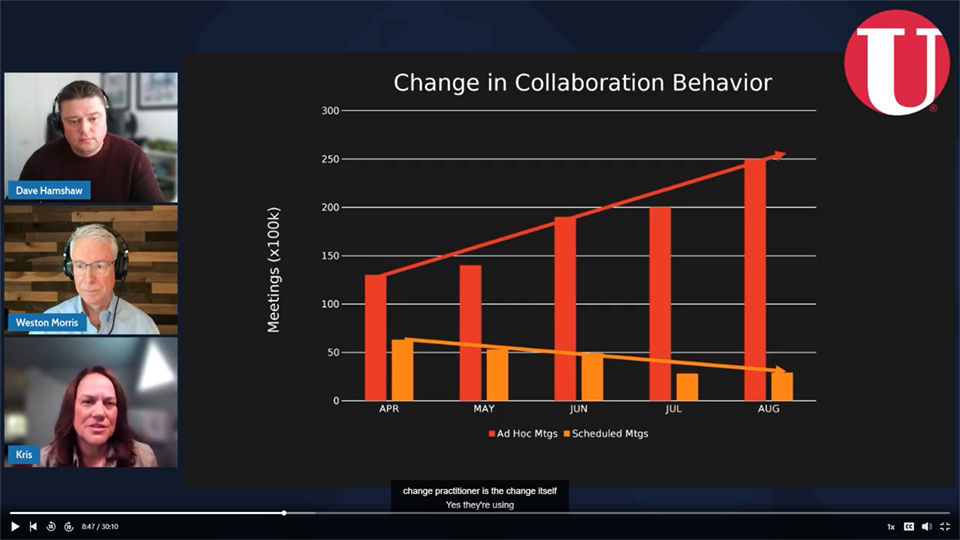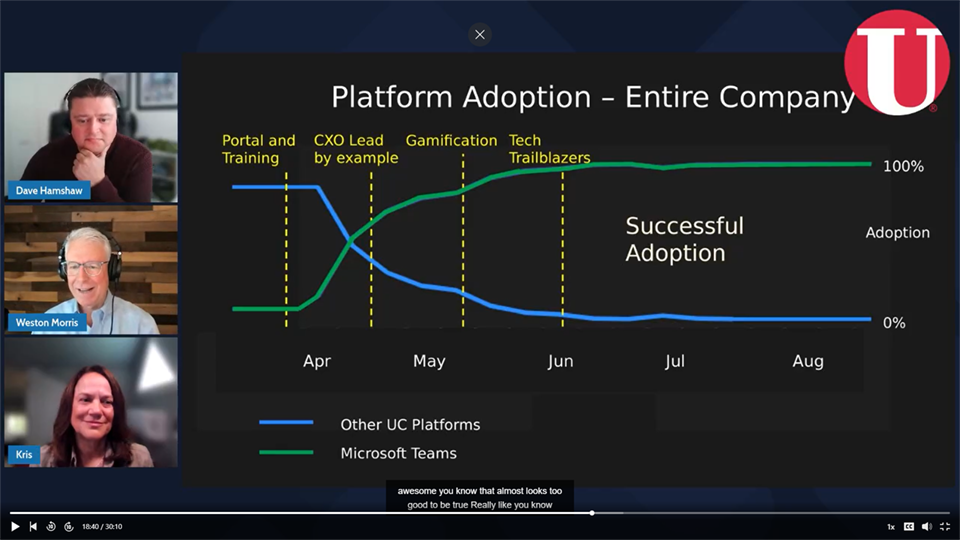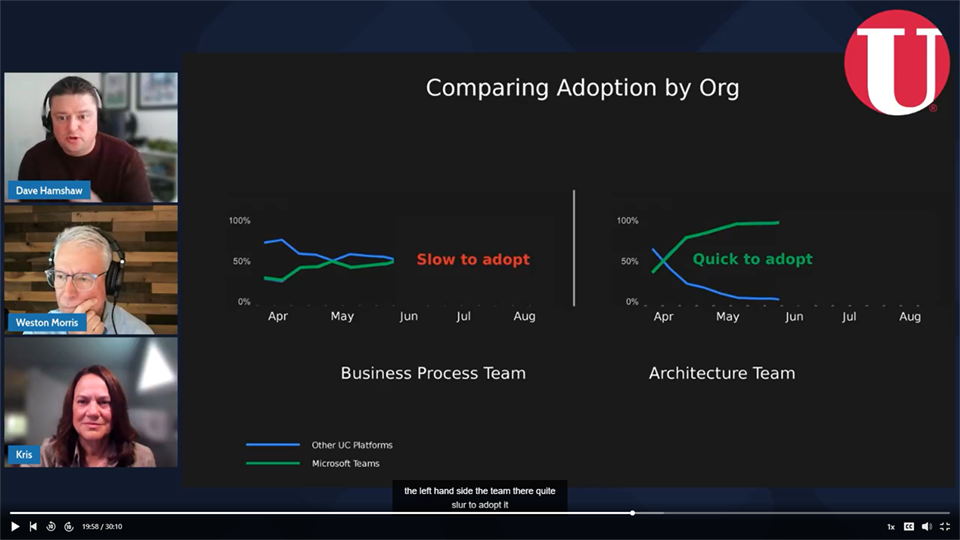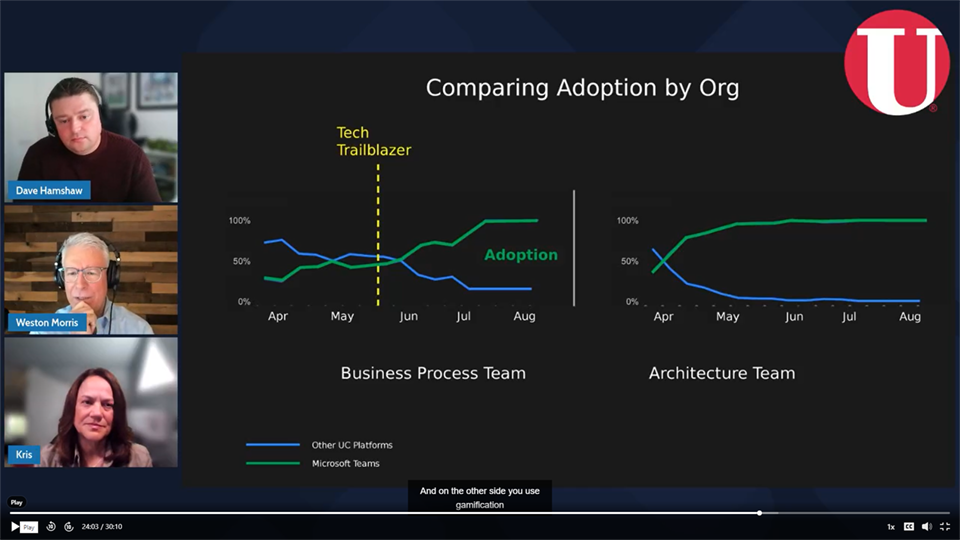Weston Morris:
Welcome to the Digital Workplace Deep Dive. I'm your host, Weston Morris.
Well, first of all, I'd like to thank you for your patience in waiting for this 40th episode. In the last few weeks, we've been working on something new using LinkedIn live sessions to give you access to video and chat, in addition to the audio that this podcast gives you. So in this episode, I collected select content from our very first LinkedIn Live session, which was dedicated to the idea of how can we use data that would be collected during a digital transformation, such as a Microsoft Teams migration to tailor the OCM, the organizational change management techniques, that might be used to get adoption during that rollout. Tell me with this, I interviewed Kris Krueger, who holds a PhD in education and training, and Dave Hamshaw, who leads Unisys digital transformation projects for clients around the world. And I asked them to share the latest OCM techniques that have been used in a recent Teams migration project. And I have to tell you, I was amazed how they were able to take OCM to the next level, actually changing corporate culture and even employee behavior while doing the team's migration by using data-driven OCM. I think you'll enjoy the interview.
Let's dig into a little bit, maybe start with the technology side, Dave, you've recently led a unified communications and collaboration (UCC) modernization at a global company, and I understand that you used OCM as part of it. You didn't just do the tech, you did the OCM at the human side. So maybe just get a little background. What was the business problem that you guys were trying to solve?
Yeah, sure. Thanks Weston. So we engaged with a client that had multiple different platforms for communication and collaboration. So their objective was to move to one secure unified platform so that chats, meetings, and, and calls were all in one place. So rather than having multiple disparate systems that they also had support, moving to one system helped people focus on that collaboration piece and talking to their colleagues. So one of the problems that arose from having the multiple platforms was the different places where presence was. So if I was working in one system and wanted to contact someone on another platform, was that presence the same as that platform? Were they in an ad-hoc meeting? Were they in a call? And bringing it all into one makes it a lot easier to have that conversation with people and collaborate.
I can see this is a probably a perfect case study because not only did you have to get the technology right, but if people don't start using it properly and know how to use it and want to use it, then still the project's a failure. So I'm really curious about the OCM side of things. Maybe you know, Kris, you can give us a little bit of primer here on, on how OCM might be used in a, in a project like this.
Yeah, well, what I think Dave highlights honestly is something that can get skipped over pretty easily, which is really understanding what the business outcomes are for the technology that you're going to implement. You know, defining those very specifically, you know, it often just successfully implementing the technology can be the measure of success. But I think you can see even from Dave's intro about what the company was looking for was more than just implementation, the technology, but actual using of it in a different way to drive collaboration in a different way.
So as I've tweeted or posted on LinkedIn about this, I've used data driven OCM over and over again. I'd like to understand a little bit about that. How was data being used in this project?
We used a piece of a software. We used a software tool to monitor these platforms. So what was key right at the start of the project and for any change management really is to understand that baseline where we were at the start. And by employing this software tool, we could see how usage and adoption was changing on those platforms throughout the life cycle of the project. So we wanted to make sure that any of the OCM activities that we were doing, we could see a tangible benefit and an uptick in adoption as we were moving along as well. So that data was really key for that, but also from a project board point of view as well, that data was being reviewed on a really regular basis so we could be quite agile in changing things or intervening if things weren't going the way that we wanted them to as well.
Let's jump to the most exciting part of, of all of this. After everything was said and done, you indicated that you saw a, not just a technology successful rollout and that people were using it, but they had changed the way that they were behaving in the company and their hybrid office and their communication. I just really want to know more about that.
Yeah, it's a really interesting point. We, and, and that is the power of the data. So we could see quite clearly the figures, what they were before and how people were using the technology over that project. So if we have a look at the first dashboard, and we've just done this a very simplified view of how the projects progressed over the months. And we can see right at the start that ad-hoc meetings was the dominant form of communication. So they were making these invites and inviting people to them, and we could see that scheduled meetings were much lower. As this project went on and once we were getting these OCM activities in there, we could see that there was a, an uptick in these ad-hoc meetings. So people were using the technology. But also from a very early stage we could see that the scheduled meetings were also decreasing as well.
So rather than people booking in a meeting and inviting maybe 10 or 15 people and having a half an hour block in the diary as the, as the project went on and the numbers should us and backed this up, those ad-hoc meetings were increasing and the scheduled meetings were going down. So from a behavioral point of view right at the start of the project, even when the client had multiple platforms, the volume of these ad-hoc meetings was lower than at the end of the project. So even going down from multiple platforms to one, the adoption of the technology showed that people were having these ad-hoc meetings, but the scheduled meetings were going down. So it was a really, really good relationship to see that over the project.
I agree that that is exciting. I mean, I think we're all aware of what a scheduled meeting is. Like, you know, we have a gazillion of them in our calendars. Sometimes it's 30 people on a call for an hour, and like your contribution might just be for a few minutes. Or at the end, you know, there's that, that meme, Oh, that meeting could have been an email <laugh> and why wasn't it an ad-hoc meeting? So that would be like, I, instead of having a scheduled meeting with all of you in preparation for this, I might start chatting with you, Dave, and then you say hey, I'm free. And then we elevate that to a video call and then, you know, hey, say, hey, let's pull Kris in. And, and then before you know what, we're doing a whiteboard, we're doing a sharing. So to note that that's even possible. And then I can do all, use all these techniques requires, you know, education and training. And I guess that's where the, the OCM comes in.
Sorry, just on that point west, so that before when we had multiple platforms and people didn't have a unified experience and the presence wasn't available, those ad-hoc meetings were hard to organize because I couldn't see, you might have been online in one platform, but offline in the other. Whereas now I can see your green and available and maybe Kris is as well, and you can have those ad-hoc meetings really on the fly. And that's, that's a real positive.
So we've talked about the results here. We've seen a change in behavior as part of this rollout. I want to get into the, the nuts and bolts, you know, what, what were the actual OCM techniques you used and, and how did that change over time? Do you, do you have something you can share with that, Dave?
Yeah, the next dashboard will cover some of the different techniques that we used. And one of the main things that we concentrated on right at the start of the project was having a single place for everyone to access training. So we created a site in SharePoint. It was embedded into Teams. So right at the start of the project we implemented a, a portal and a, a training site, but we did that embedded into Microsoft Teams. So that was available to everyone. They weren't having to go to a, a separate website or ask someone where it was, it was inside the tool. So we launched that very early on and we could see people consuming that. And another important thing as well was that we got the project board using the tool right from the start. So when we were communicating about the project, we were doing it inside Microsoft Teams.
We weren't sending email, we were having these ad-hoc meetings. If we wanted some information, we were just picking up our headsets and we were just having calls with people. So we saw that happen relatively quickly. The, the CXO leading by example, and within a few days of this launching, we had excellent adoption rate for the, the C level in the client. So we could see right from the very start from the top people were using the new platform. And this really helped us filter down that message to other people throughout the organization as well. So a really good thing to, in any change management project, having the stakeholders in their right at the start and pushing that message is, is really good. So along the way as well, we worked with Microsoft to promote knowledge of Microsoft Teams through a gamification approach to OCM.
So every month we had a quiz where there were questions to ask. So they started off really basic. So we were talking about things like, I've opened Microsoft Teams, I've had my first ad-hoc meeting with someone with a colleague, or I've called an external client and spoken to them. But as those quizzes progressed through the project, they got more advanced as well. And we were asking the client associates to come up with feedback that they've put forward that they've used personally for adoption as well. So we got some really good feedback about how they'd promoted adoption in their particular area as well. And the champions program. So internally, the client had called these the tech trailblazers. So a champion program is, is fabulous for any, any project like this. In terms of change management, and these were users that were in different geographical locations, different levels of seniority, different business units, but also different levels of knowledge as well. So we could look at people that had been using the platforms before and maybe they were nervous about this new change, but we brought them on board, we put our arm around them and said, We want you to be part of this. Your feedback is really valuable. And we could use those tech trailblazers through the project as well to help promote that adoption.
Well, I'm going to interrupt the podcast here just for a second to fill in a gap or two for those that are you that are listening to the podcast. Dave has just walked us through four OCM techniques that his team used based on the data collected during the team's migration that he operated on. And now Kris is about to comment on the effectiveness of each of these four techniques, a portal with training, getting the C-suite to lead by example, gamification, and then lastly using tech trailblazers. Now in the podcast notes, I'll provide links to the video of the dashboards that Dave and Kris are referring to. In the meantime, let's listen to Kris's observations.
Yeah, and there's a lot here. I mean, going left or right, I mean the beginning part there with the training, I think a lot of us as change practitioners would know that we need to, you know, help people learn how to use a new tool. But one of the advantages of this particular technology with Teams is that it enabled you to build that into the actual application itself and it created kind of a forced use of the tool even to go do the training. And it's a really subtle thing, but ultimately you're just looking to make the adoption piece or the learning piece or the change behavior as easy as you possibly can. And when you can centralize things like this in one spot and drive people to it, that makes it easy. And we're all looking for an easy way to learn something new.
The next one to the right with the, the CXO and the engagement there and, and use of the tool. I think, you know, in change management world, we would call that sponsorship and we spend a lot of time trying to identify the correct sponsor and, and at what level, et cetera. But ultimately, you know, people will follow when the behavior of their leaders is very strongly leading them towards that direction. And if anything right here, if we would've found that the adoption didn't change, then that would lead us to go back and reevaluate sponsorship. And it also tells us a little bit about the culture of the organization that this CXO level person was viewed in, in such a powerful way ultimately, that people immediately said, Oh, I'm going to start doing this too. The gamification in tech trailblazers pieces are again really creative ways that are fun that get people involved and kind of pull along those straggler people that aren't quite sure and are kind of waiting to find out what's going to happen.
And then the tech trailblazers, you know, good use of the informal peers and the idea of change agents just ultimately pushing the curve there. And I'm sure that, you know, we're about to get a chance to see how Dave and team looked at outliers from this or, or folks that we're still resisting. But ultimately what I love about this is, is the assumption that you're making as a change practitioner is that you're going to figure out ways to help them and get them engaged and, and as opposed to coming from an angle of, you know, why aren't they? And, and I think Dave and team did a great job of kind of embracing each group and helping them get to the next place of adoption.
Yeah, and this is just one example here, I think it's a really good one, but Kris, I know in talking with your team another technique that I've seen used recently, and it's kind of tied in with the CXO lead by example, but a podcast and I know one company had multiple business units that your team worked with, and the business units were so different. They felt like, hey, a, a CEO message out to everybody or an email coming out, even from that level wouldn't have the same power as having the next level or two down saying, Hey folks, this is our group, this is how we're going to use it, this is why we're doing it, and I need you to be on board. And that was another, you know, cool technique that can be used.
Yeah, and, and I think Weston, you're pointing out really like a lot of us know that the what, you know, we can lay out the what of the different items that you can do to manage change and help people adopt, but it's, it's knowing how and when and why you're going to use each technique. And, and the more you can have sources of information, whether it's informal feedback or actual hard data like we were able to use here, the better job you can do to drive that along. Yeah, great example.
That just, that just tees up very nicely where I want to go next. And that is how do you decide, you know, whom to reach out to and what techniques to use? Dave, you're telling me data driven, this looks awesome, you know, that almost looks too good to be true, really like, you know, 20,000 or 3000 people, whatever it was all kind of on board. Is this true across the board or did you, as you drill down to the data, did you see groups that were, you know, laggards and needed extra help or what, what did you see there?
Yeah, so I'm sure Kris will echo this. It would be wonderful if that graph represented every change management projects that we do. But we would, we would always address that and by using data we can actually see that really clearly with, with the dashboard. So the next dashboard is we built using the data was comparing the different business units and we could even drill down to a geographical location as well. So if we'd see something where the adoption rate is not quite where we wanted it to be, we could get in touch with those people. So the, the next dashboard will, we'll share that and I'll, I'll do a little bit of a comparison between, between the two.
Yeah, I'd like to see that.
Here we go. So again, over the, the same timeframe we've got the adoption of Microsoft Teams compared to the, the other unified comms platform and there's a quite a, a striking difference between the two there. So on the left hand side, the team there quite slur to adopt. It looked like they were changing over and then it kind of stalled a little bit, whereas
Backwards a little bit, didn't they?
Yeah. Yeah. So that was interesting to pick up as well. Again, something we wouldn't have seen without recording all of these data points and, and keeping on top of that information. And on the right hand side, the quick to adopt the, the early changeover, relatively within the first couple of weeks of the project, they were committed to the change and the adoption curve was similar to the, to the overall company curve. And so what we did to, to address this was use that tech trailblazers team to make contacts with them. So we contacted leaders and we never took the approach of why are you not using the tool? It was always around, We can see that adoption's not picking up, Is there anything that the platforms did before that Teams doesn't do now? Is there some knowledge gaps? Tell us what we need to, to make, make this good for you and how you want to work with the platform. And we really saw that. You can see on the left hand side there, the, the adoption, once that intervention was made and we started engaging with them a little bit more and put that arm around them, that's where we saw the adoption go up and we got things back on track towards the, the end of that project.
Ultimately, the work that Dave and his team did with us is, is around enabling change, right? We, we don't want to react and manage it. We want to enable it, we want to find out where people are getting stuck. We want to find out, you know, what they might be missing and help them realize where they can get that same thing and the new technology or ultimately just what can we do to help. And this graph, you know, kind of shows how the tech trail laser technique was also a part of helping drive the adoption from these groups that were a little bit stuck.
And David, I'm kind of curious about this tech trailblazer. Let’s drill down into it a little bit. I mean, I'm seeing two possible choices. One, I find somebody that's already in the organization that loves the new tech mm-hmm. <Affirmative> and I think that would be a natural, you know, candidate to be a tech trailblazer or what, what about if I got somebody in the organization that just is like, I hate it. I don't want this new tool over my, you know, over my dead body. You know, you're going to, you start using this, but, but if you could turn them around, they become like maybe the best advocate. I mean, what tech how did you decide?
So we looked at clients internal communication about the current platforms and from the initial feedback survey. So part of our change management is the communication to end users. We got feedback from that as well. And we could pinpoint where there were some of these concerns around moving to the new platform and by actually targeting those users and saying, This is going to be a journey that we want you to come on with us as well and let's have a look at those concerns and address them. And that, that was part of the project as well. So there were some things raised in feedback where I could do this before and maybe I can't do it the same way now. And we offered workarounds and we worked on specific situations and scenarios where maybe they were a little bit nervous about using it, but then as the project went on as well, if that new feature was released in Microsoft Teams, as it happens regularly, we know from Microsoft it's always evolving. We were also communicating that back to those people as well. So that helped to include them in the process and made them feel more confident with that tool as well.
And, and, and on the other slide, you used gamification. You gave away prizes essentially, and yeah. Was that, how did you decide to do, Was that connected like with a quiz or the 50th person to use it or, you know, what, what was the technique there?
So again, using the single SharePoint site in the training portal, we posted a, a quiz on there is short quiz every month. Again advancing from basic techniques and features in Microsoft Teams through to more advanced things like using together mode or using presenter view in, in PowerPoint. So people were answering these and we also had the free section at the bottom that looked at what have you done within your team to promote adoption of Microsoft Teams? And those comments were really valuable and we, we could use those as good pointers of adoption within the business unit, but also engage with those people as well. So we worked with Microsoft to hand hardware out at the end of the month. We've selected some winners and we worked really closely with, with Microsoft and their marketing team as well to, to organize that. So that was a, a nice added extra and another OCM technique that we saw some really good results from. So that helps drive people with the application.
Yeah, and ultimately using all these different methods is, is really powerful. I, I think we know at this point that some of the old methods of reaching stakeholders and end users like email are quickly becoming <laugh> passe and they, they don't really work. And so all of us have to kind of challenge ourselves to find new and really powerful ways to communicate that don't rely on these old ways of exchanging information. You know, I think even as OCM continues to evolve, it's being able to put yourself in the end user seat and help make that end user adoption experience easy and not very time consuming. Because the other piece that, that word battling against is just kind of the finite limit of time and how busy we are every day.
Hey, question coming in from Sonya, for you Dave, roughly how many people were involved with the gamification? How many people, what was the percentage of the population that participated in that method?
I would say with the responses that we were getting every month, it wasn't a high percentage, probably 20% to 30%. But I think what's key here is that we used so many different methods for OCM. So we talked about the email there Kris, and we all know that, that the old company email exists, but we recognize that some people will have 15,000 things in their mailbox and it may get lost in there. So even though that was a relatively small percentage we were hitting people within other areas as well. So it was in team meetings, it was in one to ones, and there were all different places where we posted this internally on the intranet. We used their internal client Yammer as well. So there were Yammer groups set up. So that's another good communication where people feel a little bit more comfortable talking about things in there. And that's quite an active area for a lot of organizations now to talk about these challenges. So yeah, we, we wanted to hit as many people as we could. So the gamification played its role in a mi in a much bigger picture adoption.
So I think we have time for maybe one final question here, and I think I'm going to direct that to you Kris. We, we've talked about a lot of different OCM techniques and, and now making sure they're data driven as well. How do you decide you have some recommendations of how do you pick which one of these to use? Or, or is it just good enough to, you know, send out an email to everybody, Hey, we're changing on July 1st. Good luck, <laugh>.
I think you already know the answer to that question right there, <laugh>. Yeah, I mean I think that, you know, ultimately it comes down to understanding your, your end users and, and how the change is going to affect them. And, and also understanding that company culture. You know, like you could apply these same techniques to a different company and a different technology implementation and it, and it won't work. And so putting in that effort upfront and staying present with it. And then, you know, the nuance here too, that we haven't talked that much about but is equally important is like being able to take the data that you're seeing and adjust. You know, having that data is great, but often people get stuck with, well yeah, it says we should do something different, but they don't have the appetite to actually make the change. And that's where the rubber meets the road where you have your data and you say, what we're doing isn't working and you adjust. And so those would be two things I'd suggest right now.
Great suggestions. Well, we have used up our time here on our LinkedIn live session and I want to thank those that joined. It looks like we have people joining from India, Brazil, United States, right down the road from Michigan. Hey, John <laugh> thank you. Thank you. And thank you for your questions and thank you so much to my guests and experts, Dave Hamshaw and Kris Kruger.
Thanks for inviting us, Weston. It's been great.
So hopefully you as an audience here, heard some innovative things in how to use OCM, especially this idea of using data driven OCM. Find the tools that expose adoption and expose usage of, of the technologies. You're rolling it out, feed that back to your OCM organization and then you can decide which is the right technique to use in not only having a successful technology rollout, but to maybe even get to that, that nirvana of changing corporate culture or, or changing employee behavior. I'm Weston Morris. Thank you for joining us today.






